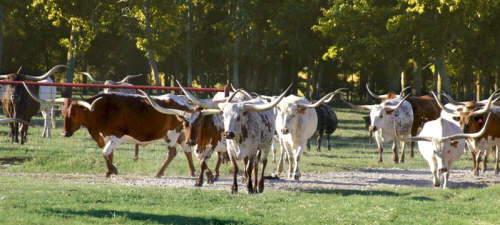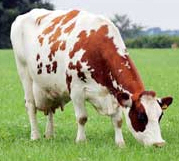



Texas Longhorn
History
The Texas Longhorn was fashioned entirely by nature in North America. Stemming from ancestors that were the first cattle to set foot on American soil almost 500 years ago, it became the sound end product of "survival of the fittest". Shaped by a combination of natural selection and adaptation to the environment, the Texas Longhorn is the only cattle breed in America which - without aid from man - is truly adapted to America. In his book The Longhorns, J. Frank Dobie states this situation well: "Had they been registered and regulated, restrained and provided for by man, they would not have been what they were."With the destruction of the buffalo following the Civil War, the Longhorns were rushed in to occupy the Great Plains, a vast empire of grass vacated by the buffalo. Cattlemen brought their breeding herds north to run on the rich grazing lands of western Nebraska, Wyoming, the Dakotas, and Montana. Thus, the Great Plains became stocked largely with these "bovine citizens" from the Southwest. And, the Texas Longhorns adapted well to their expanding world. They had reached their historical heyday, dominating the beef scene of North America like no other cattle breed has done since. However, the romantic Longhorn era came to an end when their range was fenced in and plowed under and imported cattle with quick maturing characteristics were brought in to "improve" beef qualities. Intensive crossbreeding had nearly erased the true typical Longhorn by 1900.
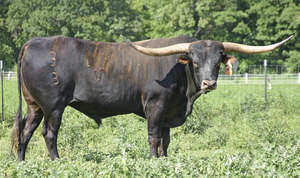 Photo courtesy of Dickinson Cattle Co. Inc. www.texaslonghorn.com |
The longhorn now appears headed along another important new trail. Lean, natural meat, offering more nutrition per calorie, is in demand, and the longhorn fills the bill. Those who have tasted longhorn beef pronounce it tender and full of flavour.
But changes in the U.S. food chain don't happen overnight. It requires 107,000 cattle every day to supply our taste for beef, and longhorns number only about 100,000. Though it will be a while before we can ask for "longhorn lean" at supermarkets, the outlook is optimistic that its singular attributes will help strengthen other breeds and thus revitalise the industry.
Characteristics
The most spectacularly coloured of all cattle, with shadings and combinations so varied that no two are alike, they reach maximum weight in eight or ten years and range from 800 to 1500 pounds. Although slow to mature, their reproductive period is twice as long as that of other breeds. Most longhorn cows and bulls have horns of four feet or less. However, mature steers have an average span of six feet or more and a 15-year-old's horn span reach up to nine feet.It does not take eight to ten years for Texas Longhorns to reach their maximum weight and they are by no means slow to mature. Texas Longhorn heifers have been known to conceive while still nursing their mother and produce a living calf without assistance before they are even 16 months old. This is not slow maturity.
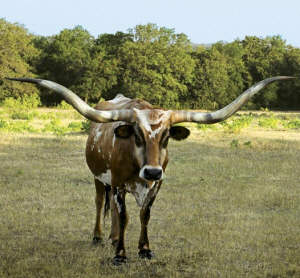 Photo courtesy of Dickinson Cattle Co. Inc. www.texaslonghorn.com |
Texas Longhorn cattle eat a wider range of grasses, plants, and weeds than do most other cattle. Texas Longhorn owners are able to use pastures that require less fertilizer and weed killers than owners of other breeds of cattle.
The Texas Longhorn produces a very lean beef (more meat less fat per ounce). Studies at major universities have shown that Texas Longhorn beef is significantly lower in cholesterol than other breeds of beef cattle. A Texas Longhorn's, who was raised on grass without chemicals or supplements, meat is lower in cholesterol than a skinless chicken breast. The Texas Longhorn owner can feel good knowing he is producing a heart healthy product for consumption. Their Meat is very tasty and a pretty bright red colour.
The Texas Longhorn is the living symbol of the Old West.
Statistics
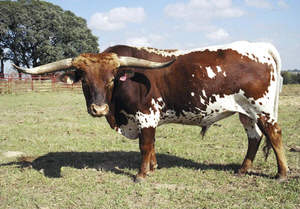 Photo courtesy of Dickinson Cattle Co. Inc. www.texaslonghorn.com |
- Lean Meat - The breed produces naturally less fat and lower cholesterol for today’s health conscious public.
- Longevity - Texas Longhorns breed well into their teens. More live calves over the years mean more dollars.
- Browse Utilisation - Less supplemental feed is needed because the cattle take advantage of the forage available.
- Disease/Parasite Resistance - A natural immunity developed over the centuries means fewer veterinarian bills and less maintenance for todays cowman.
- Reproductive Efficiency - Large pelvic openings and low birth weights result in live calves. Busy cattlemen can say “goodbye” to sleepless nights.
- Docility - Longhorn cattle are intelligent, easy to work and to handle.
- Adaptability - The breed thrives in climates from the hot, damp coastal regions to the harsh winters of Canada.
- Hybrid Vigour - Heritable quality enhances your present breed and gives you a new genetic pool.
- No two Texas Longhorns are alike. They all differ in colour pattern, size, horn length, and personality.
- Tradition and Nostalgia - The Texas Longhorn is the living symbol of the Old West. Wherever the western influence is desired-front pasture, cattle drive, or tourist attraction-you’ll find a demand for this magnificent breed.
- Horns and Hide - The Texas Longhorn is worth money even after it has outlived its usefulness as a beef producer. Top dollars are paid for the horns, skulls, and mounts that are used in the popular Southwestern decor of businesses and homes.
- Pure Pleasure - Intelligent and easy to work with, the Texas Longhorn is easily trained to exhibit in the show ring, lead or drive in parades, pull wagons, and yes, even to ride!
Comparative
Distribution
Texas Longhorns are becoming fairly popular and are mainly distributed across America and Canada although some Texas Longhorn exports are gaining pace.References (the above information was cited from the following sites)
www.ansi.okstate.edu
www.texaslonghorn.net
http://www.tlbaa.org
www.texaslonghorn.com
